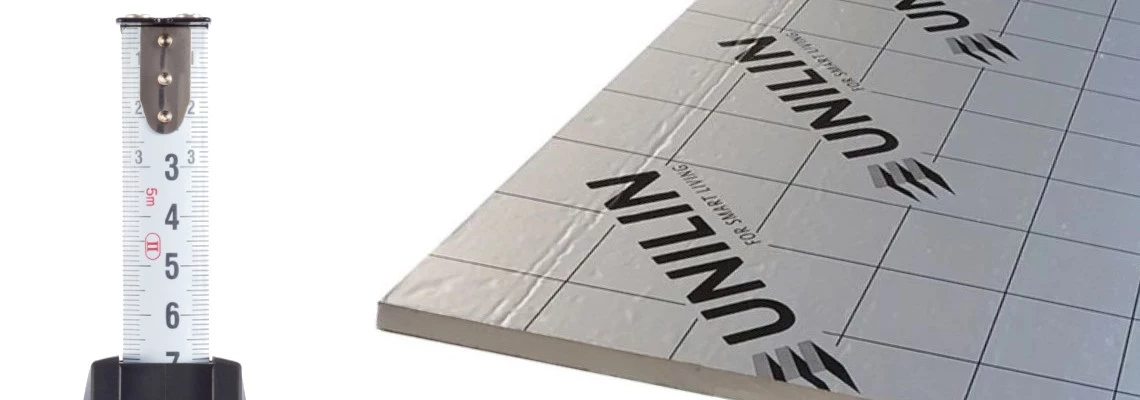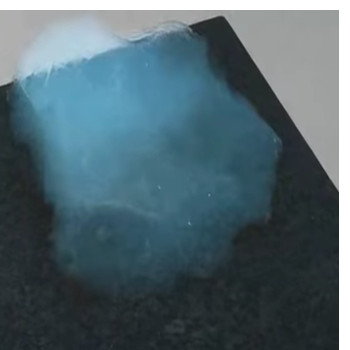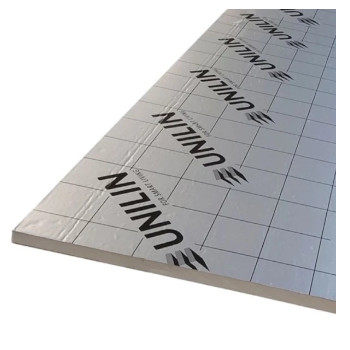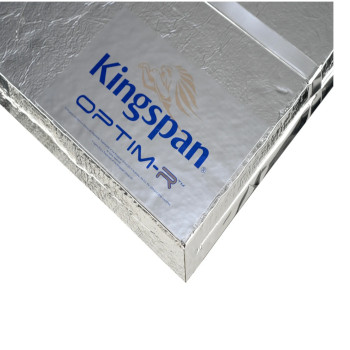
THINNEST INSULATION OVERVIEW*
Spaces in the UK are becoming increasingly precious, and the relentless surge in energy prices is a central factor contributing to the current cost-of-living challenges in Britain. In response to these escalating costs, insulation manufacturers are constantly innovating to provide ingenious solutions that not only save on energy bills but also maximise the use of living spaces.
Whether you're grappling with limited space for traditional, bulkier insulation, or you're in the process of insulating a campervan or boat, this article will introduce you to the world of 3 products that are sure to pique the interest of many readers. We'll showcase Unilin's product, long known as Xtratherm, with a thickness of just 15 mm, the innovative 10mm Aerogel blanket produced by THERMABLOK Aerogels and 20mm Kingspan Optim-R Vacuum Insulation Panels. With these solutions, you'll discover how to achieve outstanding insulation without the need for excessive space, all while contributing to maintaining a comfortable and environmentally-friendly living environment.
WHY USING THINNEST INSULATION IS SO IMPORTANT?
In many situations, such as small apartments, tiny homes, or retrofitting older buildings, there's limited space available for traditional thick insulation. Thin insulation allows for efficient use of available space, maximising the usable area of a structure. Within historic London buildings with architectural detailing, it offers a solution for an otherwise impossible area to insulate, with minimum effect on character.
Thin insulation materials often have a smaller environmental footprint compared to thicker alternatives. Thin insulation offers architects and designers greater flexibility in their designs. It allows for sleeker, more modern aesthetics while still meeting energy efficiency and building code requirements.
Thin insulation materials are often more cost-effective than thicker alternatives, not only because they use fewer materials but also because they can be easier and quicker to install. This can lead to substantial savings on both material costs and labour expenses.
WHAT IS THE THINNEST INSULATION AVAILABLE?
15mm Unilin(Xtratherm) is the thinnest and easiest solution to insulate hard to treat areas, especially where space is at a premium and where critical tolerances have to be achieved. For those who seek not only thinness but also exceptional insulation performance, 10mm Aerogel Blanket stands out as a thinnest material that offers remarkable thermal properties.
TOP 3✔ EXTRA THIN INSULATION PRODUCTS
① 10mm AEROGEL BLANKET THINNEST INSULATION | Aerogel Technology
 The thinnest insulation material currently available on the market is the 10mm Aerogel blanket. Its manufacturing technology is highly interesting, and its appearance resembles frozen smoke. For some, aerogel is synonymous with time frozen and suspended in space.
The thinnest insulation material currently available on the market is the 10mm Aerogel blanket. Its manufacturing technology is highly interesting, and its appearance resembles frozen smoke. For some, aerogel is synonymous with time frozen and suspended in space.
Aerogel, the lightest and least dense solid insulation material on Earth, defies conventional expectations. It's a substance that blurs the lines between liquids and solids, crafted from a jelly-like structure. Within this material lies a network of interconnected nanometer-sized silicon dioxide particles, forming a porous framework with countless tiny pores. To put its astonishing properties into perspective, just one gram of aerogel, if spread out and exposed, could cover an entire football field.
Often likened to frozen smoke, aerogel is visually intriguing. It allows light to pass through while effectively blocking the transfer of heat. Remarkably, it offers 39 times more insulation than even the best fibreglass insulation on the market. The impact of Aerogel Insulation is truly impressive; a mere 10mm layer can enhance the insulation capabilities of a standard solid wall construction by a staggering 67%.
Despite its low density, aerogel boasts incredible strength, withstanding compression forces up to 4000 times its own weight. However, it's worth noting that despite this remarkable compressive strength, it is also quite brittle.
One of its most exceptional attributes is its thermal insulation capability. This arises from its unique structure, creating a tortuous and porous path that significantly hinders the conduction of heat, both through the solid material and the gas within its structure.
Although aerogels have been known since the 1930s, it's only in the last two decades that intriguing applications for this material have emerged.
Aerogel holds potential for use by NASA in spacecraft insulation, and currently, it is being employed for residential insulation. With an exceptional thermal conductivity rating of 0.0015mW/mK, aerogel insulation products find utility in scenarios where traditional insulations would be impractical due to space constraints. This is particularly crucial in cases where sacrificing space might jeopardise safety or the visual appeal of the project.
Thanks to its hydrophobic nature, which offers no path for liquid transport, it remains impervious to moisture and the effects of ageing. This exceptional trait translates to significant, long-lasting energy savings throughout the building's lifespan.
② 15mm UNILIN PIR THINNEST INSULATION | Thin-R Technology
 The Unilin company, also known as Xtratherm®, utilises advanced Thin-R technology to offer the thinnest available insulation, effectively preventing thermal and cold bridging. Indeed, Unilin® is one of the few companies (next to Celotex and 12mm TB4000) that has managed to develop an incredibly thin insulation material, a feat made challenging by the requirement to maintain a 15mm thickness.
The Unilin company, also known as Xtratherm®, utilises advanced Thin-R technology to offer the thinnest available insulation, effectively preventing thermal and cold bridging. Indeed, Unilin® is one of the few companies (next to Celotex and 12mm TB4000) that has managed to develop an incredibly thin insulation material, a feat made challenging by the requirement to maintain a 15mm thickness.
So, how does this company produce such a thin insulation material? The secret lies in the Thin-R technology itself.
The primary raw materials are blended with various catalysts and additives before being evenly distributed onto a moving conveyor. The chemical mixture begins to expand, thanks to the effects of a blowing agent, resulting in the formation of foam. Precise spray nozzles ensure an even foam application, and its expansion is closely monitored. The foam continues to expand until it comes into contact with the top layer of facer material as it enters the oven, where it is cured under heat to create a rigid, thermoset foam board. The 15mm dimension is meticulously controlled using presses, with the top layers of aluminium foil serving as the finishing touch.
WHERE IS 15mm THINNEST INSULATION USED?
This remarkably thin insulation product finds applications in places where traditional insulation is typically too thick. One excellent example is its use in campervan insulation. As every millimetre in a campervan is precious, the 15mm Unilin product is perfectly suited for this purpose. Increasingly, this product is being used to insulate cold bathroom walls and basements.
Due to its cost-effectiveness, it is also highly favoured for roof insulation. It is an indispensable solution for covering all thermal bridges and junctions of thicker insulation. Thanks to its high compressive strength of 150 Kpa, it is suitable for use in flooring applications. When installed tightly within office partition walls, it also serves as sound insulation. Furthermore, it is invaluable in applications such as refrigeration units, cooling equipment, and summer houses. Increasingly, 15mm Unilin PIR insulation is also being used as an insulation material for flat roofs. When combined with a 6mm plywood layer, it creates an exceptionally solid foundation for roofing felt or membrane.
IS 15mm UNILIN PIR INSULATION EXPENSIVE?
Considering its widespread use, one can conclude that this thin product is relatively affordable, with a cost of less than £11 per square metre. A single board measuring 2400 x 1200mm costs around £31, depending on the store where it is purchased. Given the space-saving capabilities of this ultra-thin insulation, its price is quite reasonable, especially considering how straightforward it is to cut. If you want to learn how to cut this thin insulation material, you can click on our article titled "How to Cut PIR Insulation." There, you will find interesting and practical tips on the tools to use for cutting it.
③ 20mm KINGSPAN OPTIM-R THINNEST INSULATION | Vacum Technology
 Another intriguing and ultra-thin insulation product available on the UK market is the Vacuum Insulation Panels made by the well-established Kingspan brand. Boasting an impressively low thermal conductivity rating of just 0.007 W/mK, these panels offer insulation performance that surpasses that of conventional insulation materials. With its exceptional thermal capabilities, OPTIM-R presents a solution for areas that were previously left uninsulated due to space constraints. In new construction projects, it can substantially improve U-values. The OPTIM-R Flooring System offers versatile insulation solutions with various dimensions:
Another intriguing and ultra-thin insulation product available on the UK market is the Vacuum Insulation Panels made by the well-established Kingspan brand. Boasting an impressively low thermal conductivity rating of just 0.007 W/mK, these panels offer insulation performance that surpasses that of conventional insulation materials. With its exceptional thermal capabilities, OPTIM-R presents a solution for areas that were previously left uninsulated due to space constraints. In new construction projects, it can substantially improve U-values. The OPTIM-R Flooring System offers versatile insulation solutions with various dimensions:
Width: Ranging from 300mm to 600mm
Length: Extending from 300mm to 1200mm
Supplied Thickness: Available in thicknesses ranging from 20mm to 50mm
This advanced insulation system also boasts an impressive compressive strength of 150 kPa at 10% compression, ensuring durability and reliability for your flooring insulation needs.
WHAT EXACTLY IS A VACUUM INSULATION PANEL (VIP)?
The heart of OPTIM-R lies in its microporous core. By removing air (evacuating) from this core, it creates a vacuum, which is then enclosed and hermetically sealed within a slim, gas-tight envelope. This unique procedure results in exceptional thermal conductivity and an ultra-thin insulation solution.
ELEVATE YOUR FLOORING WITH KINGSPAN OPTIM-R
It's crucial to consider that when opting for thicker floor insulation, it may necessitate the removal of more existing materials, potentially affecting components like ground floor door lintels, radiators, and skirting boards. This could potentially lead to increased installation costs and project duration, especially when replacing a concrete floor. The OPTIM-R Flooring System offers a robust solution for insulating floors.
The Kingspan OPTIM-R® Flooring System comprises two essential components: OPTIM-R® panels and Kingspan OPTIM-R® flex infill strips. To streamline each project, a specialised design service is included, ensuring the optimal ratio of OPTIM-R® panels to OPTIM-R® flex. The panel layout is thoughtfully crafted and presented for client approval, providing clarity on the size, quantity, and precise placement of OPTIM-R® panels, as well as any necessary OPTIM-R® flex strips.
For further details, please refer to the provided link.
CONCLUSION
Throughout this article, we've examined three of the thinnest insulation materials available on the market: 15mm Unilin, 10mm Aerogel Blanket, and 20mm OPTIM-R Kingspan. Each of these materials has its unique properties and applications.
If you prioritise maximising available space and need a solution with a thin profile, 15mm Unilin can be an excellent choice. It provides effective insulation without taking up too much room.
For those who seek not only thinness but also exceptional insulation performance, 10mm Aerogel Blanket stands out as a material that offers remarkable thermal properties and outstanding efficiency.
On the other hand, if you prioritise efficiency and cost-effective project optimization, 20mm OPTIM-R Kingspan may be the right solution. Its ability to achieve a low thermal conductivity factor can help you achieve high energy efficiency.
Regardless of your choice, using these thin insulation materials can contribute to energy savings, improved comfort, and sustainable construction.
Related articles:
SMART THERMAL INSULATION THAT'S CHANGING THE GAME.
SPRAY FOAM INSULATION - IS IT REALLY THAT GOOD?
THE PRICE OF COMFORT: UNRAVELLING WHY INSULATION IS SO EXPENSIVE
WHAT TO CONSIDER WHEN CHOOSING INSULATION MATERIALS
Pictures credit:
isolatiemateriaal.nl, unilin.co.uk, youtube.com/watch?v=kHnen2nSmDY
*All the information provided in the content published on Insulationgo blog is for informational and educational purposes only. Insulationgo LTD makes every effort to ensure the accuracy and timeliness of the content, but we do not assume any responsibility for any errors or omissions.
The information presented on this blog should not be considered as professional advice or a substitute for consulting relevant experts. Before making any purchase decisions or taking action based on the information presented here, it is strongly recommended to contact the product manufacturer directly to verify the details and ensure its suitability for your specific needs.
Any descriptions, drawings, photographs, data, proportions, weights, measured values etc. given herein may change without prior notice and do not constitute the agreed contractual quality of the products. It is the responsibility of the recipient of all products to ensure that any proprietary rights and existing laws and legislation are observed.
By using this blog, you acknowledge and agree that Insulationgo LTD shall not be held liable for any damages, losses, or inconveniences arising from the use or reliance on the information provided herein. This limitation of liability applies to all users of the blog, including but not limited to visitors, readers, and subscribers.










































































































